Papers by Akhlaqur Rahman

Sustainability
For the suggested site in the Maldives, this research paper analyzes the possibility of a hybrid ... more For the suggested site in the Maldives, this research paper analyzes the possibility of a hybrid renewable microgrid that is dispatch strategy-governed in both off-grid and on-grid scenarios. The planned microgrid’s techno-environmental-economic-power-system responses have been assessed. Both the power system response study and the techno-environmental-economic study of the modelled microgrid were carried out using the software platforms DIgSILENT PowerFactory and HOMER Pro respectively. Cycle charging (CC) dispatch technique had the lowest performance for both on and off-grid modes, according to the research, with cost of energy (COE) of 0.135 and 0.213 dollars per kWh, and net present costs (NPC) of 132,906 and 147,058 dollars respectively. With an NPC of 113,137 dollars and a COE of 0.166 dollars/kWh, the generator order strategy operates optimally while in on-grid mode. On the other hand, load following operates at its finest in off-grid mode, with a COE of 0.024 dollars/kWh and...
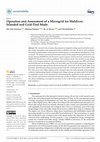
Sustainability
This research work examines the prospect of a dispatch strategy governed hybrid renewable energy ... more This research work examines the prospect of a dispatch strategy governed hybrid renewable energy microgrid for the proposed location in Maldives for both off and on grid conditions. The techno-environmental-economic-power system responses of the proposed microgrid have been evaluated. The techno-environmental-economic analysis of the proposed microgrid has been conducted utilizing HOMER Pro and the power system response analysis has been conducted using DIgSILENT PowerFactory software platforms. The evaluation shows that, for both on and off grid modes, cycle charging strategy has the worst performance having net present costs (NPC) of $132,906 and $147,058 and cost of energy (COE) of 0.135 $/kWh and 0.213 $/kWh respectively. During on grid mode, generator order performs the best having NPC of $113,137, COE of 0.166 $/kWh. In off grid mode, load following strategy performs the best with NPC of $141,448 and COE of 0.024 $/kWh. The active power and voltage responses of the microgrid s...

2019 International Symposium on Advanced Electrical and Communication Technologies (ISAECT)
In recent times, there has been a increasing trend towards attention for the production of electr... more In recent times, there has been a increasing trend towards attention for the production of electricity from alternate/innovative sources of renewable energy due to the everincreasing need for sustainable yet environment-friendly and lowcost production approaches (i.e., solar, wind, wave, hydro-power etc.). Pathar Kuchi Leaf (PKL) is one such promising source of electricity generation where electro-chemical conversion of energy provide the means to work as an alternate source of cell/battery. Especially in the context of a developing country like Bangladesh, this new form of biomass energy (PKL) possesses a great potential to fulfill the energy demand of rural people, who live under the poverty line. However, the key performance criteria for PKL cell is the assurance of efficient generation of electricity, since it plays a key role in supplying cleaner and proficient electric power to the consumers. Therefore, this paper proposes an experimental study of cell efficiency of PKL (Pathor Kuchi Leaf), on top of the previous analysis provided on this topic in the literature. To be precise, a thorough analysis has been performed in this paper to assess the performance of PKL cell in terms of voltaic efficiency, coulombic efficiency, and energy efficiency. The results from experimental data suggests a nearperfect energy efficiency of PKL cell for our proposed test-bed. With respect to the scope of the work, the overall aim has been to introduce/establish this emerging form of biomass energy to the modern world and discuss it’s important characteristics.

2020 International Conference on Smart Grids and Energy Systems (SGES)
With the aim of developing smart standalone systems for improving power generation, this paper is... more With the aim of developing smart standalone systems for improving power generation, this paper is focused on implementation of a hybrid stationary exercise bicycle for generating electricity with increased output power. With that in mind, the concept of magnetic forces has been utilized to assist the cyclist pedaling action, which further enhances the performance. Additionally, an alternator is re-arranged as motor is connected as well as operated as part of the hybrid system. While implementing, the design is benchmarked against a basic cycling assisted power generation system. As for the result analysis, both aforementioned systems are tested for the same loaded conditions. According to the findings of the paper, the proposed hybrid system tolerated higher loads, reached a higher maximum speed and output 17.4% more usable power, thus ensuring better performance.
2020 International Conference on Smart Grids and Energy Systems (SGES)
In this paper, a new approach for load profile segmentation is investigated for residential energ... more In this paper, a new approach for load profile segmentation is investigated for residential energy consumption. The proposed approach considers the daily level granularity and identifies dominant patterns of energy consumption for individual participants. The analysis uses adaptive k-means clustering to determine the number of clusters that improve the distances between data points and cluster centroids. The proposed method is applied to Ausgrid Solar Home Electricity Dataset for energy consumption data of 300 houses over 1 year. The results demonstrate distinctive features including peak energy consumption, time of peak energy use, as well as seasonal variations. The findings can help utilities to optimise demand response and pricing strategies.

2020 IEEE Green Technologies Conference(GreenTech)
In the current state-of-the-art for smart grid technology, A key proponent for progress has been ... more In the current state-of-the-art for smart grid technology, A key proponent for progress has been the advances made in the domain of smart meters. Essentially, smart meters are digital devices that use the wireless radio frequency (RF) technology to communicate in real-time with the energy utility company. Similar to their cell phone counterparts, smart meters too remain accessible and maintain compatibility by employing wireless infrastructure. As a consequence, smart meters emit RF radiation. While a lot of studies cover topics related to the level of impact RF radiation causes, the objective of this paper is to show how the radiation power of a single unit smart meter is absorbed by the human body, more specifically, by the human head. Health concerns already arise for smart meters, also known as advanced metering infrastructure (AMI). To maintain the RF exposure regulation by FCC, IEEE, and ICNIRP, the specific absorption rate (SAR) calculation is an important issue. To the author’s best knowledge, this paper reviews the analytical power and SAR calculation as well as shows the results to increase the public awareness for smart meter radiation.

Energies, 2022
Peak load reduction is one of the most essential obligations and cost-effective tasks for electri... more Peak load reduction is one of the most essential obligations and cost-effective tasks for electrical energy consumers. An isolated microgrid (IMG) system is an independent limited capacity power system where the peak shaving application can perform a vital role in the economic operation. This paper presents a comparative analysis of a categorical variable decision tree algorithm (CVDTA) with the most common peak shaving technique, namely, the general capacity addition technique, to evaluate the peak shaving performance for an IMG system. The CVDTA algorithm deals with the hybrid photovoltaic (PV)—battery energy storage system (BESS) to provide the peak shaving service where the capacity addition technique uses a peaking generator to minimize the peak demand. An actual IMG system model is developed in MATLAB/Simulink software to analyze the peak shaving performance. The model consists of four major components such as, PV, BESS, variable load, and gas turbine generator (GTG) dispatch ...
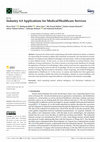
Journal of Sensor and Actuator Networks, 2021
At present, the whole world is transitioning to the fourth industrial revolution, or Industry 4.0... more At present, the whole world is transitioning to the fourth industrial revolution, or Industry 4.0, representing the transition to digital, fully automated environments, and cyber-physical systems. Industry 4.0 comprises many different technologies and innovations, which are being implemented in many different sectors. In this review, we focus on the healthcare or medical domain, where healthcare is being revolutionized. The whole ecosystem is moving towards Healthcare 4.0, through the application of Industry 4.0 methodologies. Many technical and innovative approaches have had an impact on moving the sector towards the 4.0 paradigm. We focus on such technologies, including Internet of Things, Big Data Analytics, blockchain, Cloud Computing, and Artificial Intelligence, implemented in Healthcare 4.0. In this review, we analyze and identify how their applications function, the currently available state-of-the-art technologies, solutions to current challenges, and innovative start-ups t...
International Journal of Advance Research and Innovative Ideas in Education, 2019
In this paper, it has been studied the I-V characteristics between ideal and non-ideal solar cell... more In this paper, it has been studied the I-V characteristics between ideal and non-ideal solar cells. The ideal curve was for before using the solar cell for irrigation and for vegetative & fruits field. It has been observed several parameters of solar cells for before and after use of irrigation and vegetative & fruits field like conversion efficiency and Fill Factor (FF). It was found that the value of the conversion efficiency and the Fill Factor (FF) decreases after use the solar cell. The I-V characteristics totally different between ideal and non-ideal solar cell.
Global journal for research analysis, 2018
This paper provides an excellent alternative to remove the accident avoidance. Nowadays most of t... more This paper provides an excellent alternative to remove the accident avoidance. Nowadays most of the countries are forcing the motorcycle riders to wear helmet and not use the vehicles when the person is in drunken condition and also when the person is use phone, smart helmet checks automatically whether the person is wearing the helmet and has non- alcoholic breath while riding. The helmet which can be applied in two wheelers to accident on roads. GPS and GSM technologies are used to find the present location of rider and sent SMS in case of accident. Here we have a RF transmitter at the helmet and RF receiver at the bike.
2019 International Symposium on Advanced Electrical and Communication Technologies (ISAECT), 2019
This paper proposes a smart system for the blind people that would allow them to avoid obstacles ... more This paper proposes a smart system for the blind people that would allow them to avoid obstacles or holes in their path. The system calculates the distance between the device and the terrain in a continuum and determines if the path ahead is flat or has obstacle. The user is informed through vibration as s/he holds the cane in hand. A laser light to throw a beam downward at a fixed angle, a camera also fixed to pick up the laser spot on the ground and a personal computer for computation were used in the prototype. We also provided a tentative design for the can that stays vertical along its way.
Approaching towards the innovation of smartest technology in the world Smart Grid is being modifi... more Approaching towards the innovation of smartest technology in the world Smart Grid is being modified day by day for the better efficiency and better performance. One of the ways to improve the efficiency or performance of the smart grid (SG) technology is to integrate the alternative energy sources within it. In this research paper, the possibility of integrating an alternative energy sources in Smart Grid technology have been discussed. And this alternative energy source is Wind Energy. If the alternative energy sources can be integrated with the Smart Grid, the efficiency and performance will increase depending on some factors like geographical location etc. In this research paper all these things have been discussed.

Sustainability, 2021
This paper presents an evaluation of the optimized design of an off-grid hybrid microgrid for alt... more This paper presents an evaluation of the optimized design of an off-grid hybrid microgrid for alternative load dispatch algorithms with the determination of the most optimal sizing of each equipment, analyzing the voltage and frequency outputs and various costs of the proposed microgrids. Kushighat and Rajendro Bazar, two geographical locations in Bangladesh have been taken as test sites. The proposed microgrids incorporating diesel generator, renewable resources, storage device, and 23.31 kW of demand have been optimized for five conventional load dispatch methodologies: HOMER predictive dispatch, Load Following, Generator Order, Cycle Charging, and Combined Dispatch to reduce the system’s net present cost, gas discharge and cost of energy. HOMER (Hybrid Optimization of Multiple Electric Renewables) software has been used for the analysis to determine the optimal sizes and costing and the voltage-frequency performances of the microgrids are analyzed using MATLAB/Simulink. From our ...
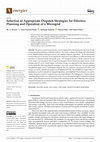
Energies, 2021
The power system responsiveness may be improved by determining the ideal size of each component a... more The power system responsiveness may be improved by determining the ideal size of each component and performing a reliability analysis. This study evaluated the design and optimization of an islanded hybrid microgrid system with multiple dispatch algorithms. As the penetration of renewable power increases in microgrids, the importance and influence of efficient design and operation of islanded hybrid microgrids grow. The Kangaroo Island in South Australia served as the study’s test microgrid. The sizing of the Kangaroo Island hybrid microgrid system, which includes solar PV, wind, a diesel engine, and battery storage, was adjusted for four dispatch schemes. In this study, the following dispatch strategies were used: (i) load following, (ii) cycle charging, (iii) generator order, and (iv) combination dispatch. The CO2 emissions, net present cost (NPC), and energy cost of the islanded microgrid were all optimized (COE). The HOMER microgrid software platform was used to build all four d...

GLOBECOM 2017 - 2017 IEEE Global Communications Conference, 2017
Task offloading opens a gateway for robotic applications to leverage computation support from the... more Task offloading opens a gateway for robotic applications to leverage computation support from the cloud infrastructure. It exploits a trade-off between the robot's and cloud's processing capabilities, and the communication between the two entities plays a critical role in making these decisions. Two major factors that significantly influence communication are network connectivity (bandwidth) and mobility of the robot. We integrate these two factors with the offloading decisions to formulate an optimization problem. Our objective in this paper is to improve the quality of service (QoS) for a 25 node application taskflow, known as direct acyclic graph. We propose a genetic algorithm based approach to solve the optimization problem which performs a novel three-layer decision making: (i) whether to offload a task or not, (ii) path planning to reach a desired location for offloading/local execution, (iii) select access point to associate with for offloading. We simulate for a smart city scenario consisting of 36-cell workspace with obstacles and compare the offloading results with a well- established fixed movement offloading method. The outcomes of our study suggest that motion and connectivity aware offloading leads to more efficient performance in terms of improved QoS and minimum consumption of resources, i.e., energy, time or distance.
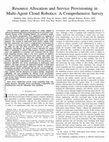
IEEE Communications Surveys & Tutorials, 2021
Robotic applications nowadays are widely adopted to enhance operational automation and performanc... more Robotic applications nowadays are widely adopted to enhance operational automation and performance of real-world Cyber-Physical Systems (CPSs) including Industry 4.0, agriculture, healthcare, and disaster management. These applications are composed of latency-sensitive, data-heavy, and compute-intensive tasks. The robots, however, are constrained in the computational power and storage capacity. The concept of multi-agent cloud robotics enables robotto-robot cooperation and creates a complementary environment for the robots in executing large-scale applications with the capability to utilize the edge and cloud resources. However, in such a collaborative environment, the optimal resource allocation for robotic tasks is challenging to achieve. Heterogeneous energy consumption rates and application of execution costs associated with the robots and computing instances make it even more complex. In addition, the data transmission delay between local robots, edge nodes, and cloud data centres adversely affects the real-time interactions and impedes service performance guarantee. Taking all these issues into account, this paper comprehensively surveys the state-of-the-art on resource allocation and service provisioning in multi-agent cloud robotics. The paper presents the application domains of multi-agent cloud robotics through explicit comparison with the contemporary computing paradigms and identifies the specific research challenges. A complete taxonomy on resource allocation is presented for the first time, together with the discussion of resource pooling, computation offloading, and task scheduling for efficient service provisioning. Furthermore, we highlight the research gaps from the learned lessons, and present future directions deemed beneficial to further advance this emerging field.

International Journal of Toxicology, 2020
Polycyclic aromatic hydrocarbons (PAHs) refer to a ubiquitous group of anthropogenic air pollutan... more Polycyclic aromatic hydrocarbons (PAHs) refer to a ubiquitous group of anthropogenic air pollutants that are generated through incomplete carbon combustion. Although the immunotoxic nature of PAHs has been previously reported, the underlying molecular mechanisms of this effect are not fully understood. In the present study, we investigated the mitochondrial-mediated epigenetic regulation of 2 PAHs, carcinogenic (benzo[a]pyrene; BaP) and noncarcinogenic (anthracene [ANT]), in peripheral lymphocytes. While ANT exposure triggered mitochondrial oxidative damage, no appreciable epigenetic modifications were observed. On the other hand, exposure to BaP perturbed the mitochondrial redox machinery and initiated cascade of epigenetic modifications. Cells exposed to BaP showed prominent changes in the expression of mitochondrial microRNAs (miR-24, miR-34a, miR-150, and miR-155) and their respective gene targets (NF-κβ, MYC, and p53). The exposure of BaP also caused significant alterations in ...
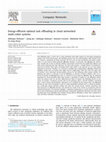
Computer Networks, 2019
Task offloading plays a critical role in cloud networked multi-robot systems for leveraging compu... more Task offloading plays a critical role in cloud networked multi-robot systems for leveraging computation support from cloud infrastructure and benefiting greatly from the well-developed cloud network facilities. However, considering the delay constraint, the extra costs of data transmission and remote computation, it is not trivial to make optimized offloading decisions. In particular, task offloading for robots is more complex due to their on-demand mobility and network connectivity that significantly influence the robot-cloud communication links. Moreover, for multi-robot systems, a suitable balance of workload between local network (robot-robot) and global cloud (robot-cloud) is also required, so as to attain proper utilization of resources. Therefore, it is essential to establish more comprehensive offloading schemes for modeling systems that can handle these higher level of complications. With that view, this paper aims to develop a novel multi-layer decision-making scheme for task offloading which jointly considers the following four aspects: (i) selection of task for offloading, (ii) selection of robot to offload a task, (iii) selection of location to offload/perform task, (iv) selection of access point for offloaded task. An integrated framework for cloud networked multi-robot systems is presented to enable our task offloading scheme where the primary robot can aid from additional local robots to improve the offloading process. In particular, we consider a warehouse scenario with 36 cell workspace where a 40 node taskflow is motivated from a "parcel sorting and distribution" application, to be completed by the primary robot. The offloading decision for each task is formulated as part of a joint optimization problem and it is solved by developing a multi-layer genetic algorithm scheme that takes into account motion, network connectivity and local sharing for its offloading decisions. We evaluate the results of the scheme via comparison with two validated benchmarks. The outcome highlights a significant improvement in overall system performance due to joint involvement of motion (path planning), connectivity (bandwidth estimation) and robot-robot communication (local offloading) that facilitates energy-efficient offloading to cloud, faster completion of tasks and better utilization of available resources.









Uploads
Papers by Akhlaqur Rahman